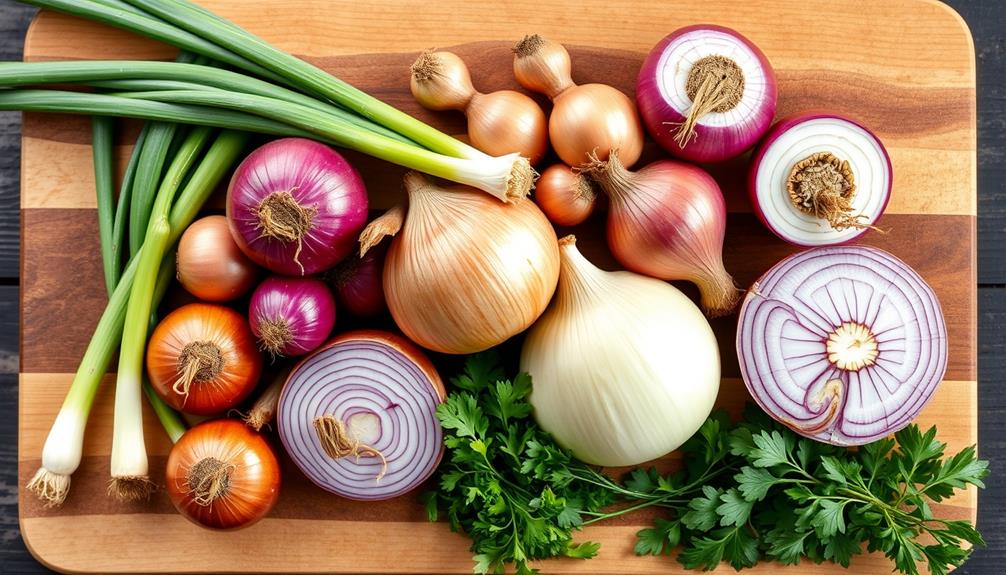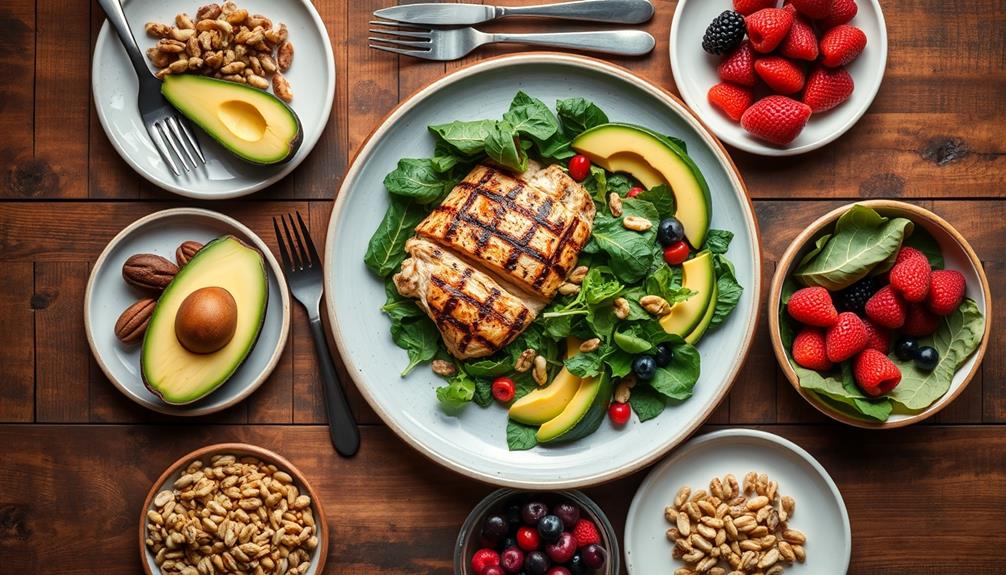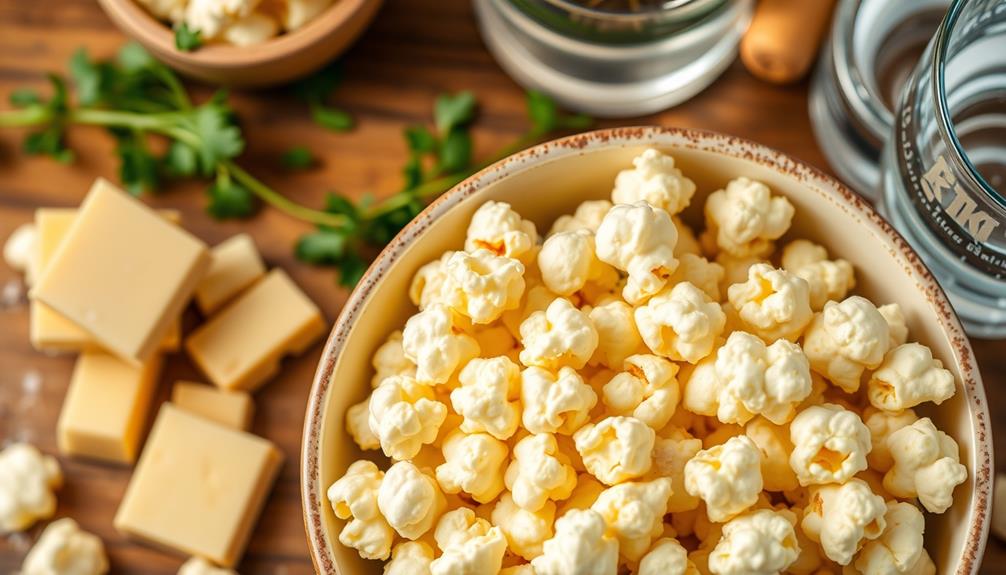The best low-carb vegetables for a keto diet include leafy greens like spinach and kale, cruciferous veggies such as cauliflower and broccoli, and certain squashes like zucchini. These options are naturally low in carbs, providing essential fiber, vitamins, and crunch without disrupting ketosis. Properly prepping and storing these veggies guarantees they stay fresh longer and are ready when you need them. Keep exploring to discover tips on selecting, prepping, and storing your keto-friendly produce.
Key Takeaways
- Leafy greens like spinach and kale are low in carbs and rich in nutrients, making them ideal for keto diets.
- Cruciferous vegetables such as cauliflower and broccoli offer fiber and antioxidants with minimal carbs.
- Zucchini and other summer squashes are versatile, low-carb options suitable for various keto recipes.
- Proper storage and meal prep of vegetables ensure freshness and make keto meal planning easier.
- Incorporating these vegetables supports ketosis, provides essential vitamins, and reduces high-carb snack temptations.

If you’re following a ketogenic diet, choosing the right vegetables is essential for staying in ketosis while still enjoying a variety of flavors and textures. Low-carb vegetables can be a challenge to select, but with proper meal prep tips and storage methods, you can keep your kitchen stocked with fresh, keto-friendly produce. Start by focusing on vegetables that are naturally low in carbs, such as leafy greens, cruciferous vegetables, and certain squashes. Incorporate these into your meals regularly to add fiber, vitamins, and a satisfying crunch without knocking you out of ketosis.
Choose low-carb vegetables like greens, cruciferous vegetables, and squashes to stay in ketosis and enjoy diverse flavors.
When it comes to meal prep tips, washing, chopping, and portioning your vegetables in advance can save time during busy weekdays. Use airtight containers to keep prepped veggies fresh longer and make it easier to grab a quick side or ingredient for your meals. For example, pre-washed spinach or kale can be stored in sealed containers, ready to be tossed into salads or sautéed. Cauliflower florets and broccoli crowns can be blanched and frozen, allowing you to have low-carb options on hand without worry about spoilage. Proper meal prep not only keeps your diet on track but also reduces the temptation to reach for high-carb snacks.
Vegetable storage methods play a critical role in maintaining freshness and preventing waste. For leafy greens, wrapping them in a damp paper towel and storing them in a breathable bag or container helps retain moisture and crispness. Cruciferous vegetables like cauliflower and broccoli should be kept in the refrigerator’s crisper drawer, ideally in perforated bags that allow air circulation. Root vegetables such as radishes and turnips should be stored in a cool, dark place or in the fridge, away from moisture to prevent spoilage. When freezing vegetables, blanch them first to deactivate enzymes that cause spoilage, then store them in vacuum-sealed bags or airtight containers. This process preserves nutrients and texture, making your vegetables last longer.
Additionally, understanding the importance of proper soil moisture and watering techniques can help keep your vegetables fresh and healthy, especially if you’re growing some at home. Choosing the right storage methods and investing in efficient meal prep tips ensures you’ll always have fresh, low-carb vegetables ready to incorporate into your keto meals. This approach minimizes waste, saves time, and helps you stay committed to your diet. With the right planning, you can enjoy a wide variety of vegetables without the risk of carb overload. Remember, the key is consistency—preparing and storing your vegetables properly means you’re always prepared to make healthy, keto-friendly meals that keep your ketosis goals within reach.
Frequently Asked Questions
Are All Vegetables Equally Keto-Friendly?
Not all vegetables are equally keto-friendly. You should focus on those with low fiber content and high vitamin levels, like leafy greens and cruciferous vegetables. These help you stay in ketosis while providing essential nutrients. Avoid starchy vegetables like potatoes and corn, which have higher fiber and carb counts. By choosing wisely, you can enjoy a nutritious, low-carb diet without sacrificing flavor or health benefits.
Can I Eat Starchy Vegetables on Keto?
You should generally avoid starchy vegetables on keto, as they don’t fit within keto guidelines due to their high carb content. Starchy vegetables like potatoes, corn, and peas can quickly kick you out of ketosis if eaten in excess. Instead, stick to low-carb vegetables like leafy greens and zucchini to stay aligned with keto guidelines and maintain your low-carb, high-fat goals.
How Do Cooking Methods Affect Carb Content?
Cooking methods markedly impact carb retention in vegetables. Boiling and steaming tend to preserve more carbs, while roasting or sautéing with oils can reduce carb content slightly by water loss. If you want to minimize carb intake, opt for gentle cooking techniques like steaming or boiling, and avoid overcooking, which can increase the cooking impact on carbs. Adjust your method based on your keto goals to control carb retention effectively.
Are Organic Vegetables Better for Keto?
Imagine you’re shopping for kale; choosing organic can be better for keto because of organic benefits like fewer pesticides. Organic vegetables often have fewer pesticide concerns, making them a healthier option, especially if you consume large amounts. While organic produce may be slightly higher in cost, it reduces your exposure to chemicals, supporting your keto lifestyle by ensuring you’re eating clean, low-carb, nutrient-dense veggies without unnecessary additives.
What Are the Best Vegetables for Meal Prep?
For meal prep, you should choose versatile vegetables like broccoli, bell peppers, spinach, and zucchini, which store well and stay fresh longer. Use meal prep tips like blanching or roasting your veggies before storing to keep their flavor and texture. Invest in airtight containers and proper veggie storage techniques to extend freshness. This way, you’ll have healthy, low-carb options ready, making your keto meals easy and delicious throughout the week.
Conclusion
Now that you know your keto-friendly vegetables, you’re armed with a vibrant palette for your low-carb meals. Think of these veggies as the steady anchors in your keto journey—grounding, nourishing, and full of life. Incorporate them into your plate, and watch how your diet becomes a colorful, flavorful adventure that keeps you energized and satisfied. With these choices, your keto path is a garden blooming with healthy, delicious possibilities.








